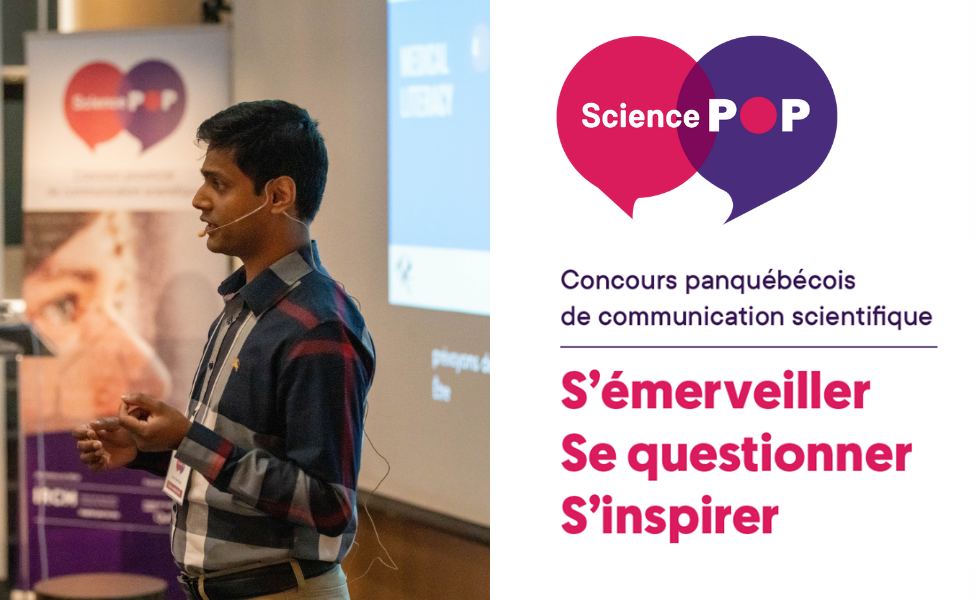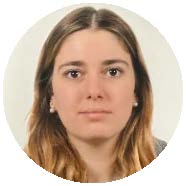
Du 11 au 12 sept. 2024
Lieu
Auditorium Jacques-Genest - IRCM110, avenue des Pins OuestMontréal, QC, H2W 1R7Canada
ContactChristine Matte, Coordonnatrice aux affaires professorales et scientifiques / Faculty and Scientific Affairs Coordinator514 987-5529christine.matte@ircm.qc.ca
Concours
Science POP : Compétition interne de l’IRCM 2024

Bienvenue à la compétition interne Science POP de l'IRCM !
L'Institut de recherches cliniques de Montréal (IRCM) est fier de proposer sa deuxième édition du concours de communication scientifique Science POP qui vise à promouvoir le dialogue science-société et l'épanouissement professionnel des étudiants et étudiantes en sciences de la santé au-delà de la recherche et du curriculum académique. La compétition interne de l’IRCM aura lieu les 11 et 12 septembre 2024 dans son Auditorium Jacques-Genest.
Vous souhaitez assister à l’évènement pour découvrir les nombreux talents qui se cachent dans notre institut? Toute personne curieuse d'en connaitre davantage sur les sciences est invitée à venir écouter gratuitement notre relève scientifique raconter leurs histoires de science dans un langage accessible.
Aucune inscription n’est requise.
Si vous souhaitez vous impliquer dans l’organisation du concours en tant que bénévole ou faire partie du jury de l’un des trois défis, écrivez-nous à sciencepop@ircm.qc.ca
Plus qu'un simple concours, Science POP se veut une plateforme permettant de mettre de l'avant les talents en communication de la relève étudiante et d'éveiller des vocations.
Les trois défis
Le concours Science POP propose trois défis distincts, chacun mettant à l'épreuve une compétence différente en communication scientifique.
- Défi vulgarisation
OBJECTIF : Expliquer un élément central de son projet de recherche
Les candidats et candidates qui relèveront ce défi devront faire preuve de pédagogie et de créativité pour expliquer une notion clé de leur projet de recherche, dans un langage clair, simple et accessible.
- Défi média
OBJECTIF : Attirez l’attention des journalistes sur votre projet de recherche
Ce volet propose à la relève de miser sur sa fibre journalistique et de produire un communiqué de presse qui met de l’avant l’importance de leurs travaux de recherche. Les candidats et candidates auront ensuite 2 minutes, pendant la compétition, pour captiver l'attention du public et le convaincre d'aller lire le communiqué.
- Défi santé durable
OBJECTIF: Témoigner de son engagement personnel envers la santé durable
Les candidats et candidates qui opteront pour ce défi devront présenter un projet personnel qu’ils ou elles souhaitent mettre en place pour favoriser le bien-être et la santé de la population du Québec.
Instigateur de l’initiative panquébécoise, l’IRCM fait partie des 13 institutions participantes. Pour connaitre tous les détails de la compétition et de sa finale provinciale qui se tiendra les 21 et 22 novembre 2024 à l'IRCM.
En savoir plus sur Science POP
PROGRAMME
Le concours est bilingue. Un service de traduction simultanée sera offert.
La compétition sera animée par Idia Boncheva, M.Sc., récemment diplômée du programme de médecine cellulaire et moléculaire (MCM) hébergé à l’IRCM.
Mercredi 11 septembre – Défi vulgarisation
8:45 – 9:00 Arrivée des participants et participantes
9:00 – 09:15 Discours d’ouverture, présentations du Défi vulgarisation et des juges
9:15 – 9:27 Vincent Lapointe-Roberge (PhD), Les facteurs pionniers à la conquête de territoires génomiques inexplorés. (FR)
9:27 – 9:39 Marianne Langlois (Maitrise), UAS-Gal4: Où-Quand-Quoi? Je décide (FR)
9:39 – 9:51 Mohammed Usama Patel (Maitrise), Type 1 Diabetes: The Sabotage Within (ANG)
9:51 – 10:03 Thais Souza Cunha (PhD), No, it isn’t just a phase! It’s two, actually (ANG)
10:03- 10:15 Nikoletta Diamantopoulos (PhD), Vaccines: how antibodies are made (ANG)
10:15- 10:40 Pause café
10:40 – 10:52 Sanidhya Jagdish (Maitrise), Senescent Workers: Heroes or Troublemakers in the Cellular Factory? (ANG)
10:52 – 11:04 Nanu Pal (PhD), Fluorescent Proteins: The Torchbearer of Biology (ANG)
11:04 – 11:16 Shayesteh Kiani (PhD), Vitamin K: The superhero fighting stress inside our bodies (ANG)
11:16 – 11:28 Reham Magdy Wasfy (Postdoc), Hidden Cargo: Tiny Gut Vesicles Could Unlock Immune System Secrets (ANG)
11:28 - 11:40 Clara Arranz Figuls (Maitrise), The Enchanted Kingdom of Breast Cancer Progression: Unveiling the PEAK1-RASAL2 interaction (ANG)
11:40– 12:00 Délibération du jury & Vote du public
12:00 – 12:10 Remise de prix pour le Défi vulgarisation
Jeudi 12 septembre – Défi média
9:30 – 10 :00 Arrivée des participants et participantes
10:00– 10:10 Mot de bienvenue, présentation du Défi média et des juges
10:10 – 10:20 Laure Alexandre-Heymann (Postdoc), Fibrose kystique : un bol d’air… allégé en sucre? (FR) - Lire le communiqué de presse
10:20 – 10:30 Thélo Garré (Maitrise), Faire des pas permet de diminuer les complications liées au diabète de type 1 (FR) - Lire le communiqué de presse
10:30 – 10:40 Bhadra Pattanayak (PhD), Molecular delivery system: How cells place order and receive delivery for healthy functioning? (ANG) - Lire le communiqué de presse
10:40 – 11:00 Délibération du jury & Vote du public
11:00 – 11:20 Remise de prix pour le Défi média
ANIMATRICE
Idia Boncheva
M.Sc.
Microbiologie et Immunologie
Animatrice
Idia est récemment diplômée du programme de médecine cellulaire et moléculaire (MCM) hébergé à l’IRCM. Elle s’est intensément formée ces dernières années à la recherche translationnelle pour lier la recherche scientifique et clinique. À l’avenir, son objectif principal est de démocratiser la science. Animer la compétition interne Science Pop sera une occasion unique de s’immerger dans l’écosystème de la communication scientifique au Québec!
PRÉSENTATION DES CANDIDATS ET CANDIDATES

Laure Alexandre-Heymann
Postdoctorante
Médecine expérimentale, Recherche clinique
Défi média
Fibrose kystique : un bol d’air… allégé en sucre?
20 ans ! 20 ans de suivi pour la cohorte de Montréalais vivant avec la fibrose kystique, une maladie rare touchant environ 1300 Québecois, qui se caractérise par des difficultés respiratoires et une dénutrition. Chez un adulte sur deux, cette maladie peut se compliquer d’un diabète (c’est-à-dire de taux de sucre dans le sang trop élevés), longtemps associé à des symptômes plus sévères et une espérance de vie réduite.
Heureusement, l’arrivée en 2022 du Trikafta, un nouveau médicament, a transformé la prise en charge de la fibrose kystique de manière spectaculaire : les participants traités par ce médicament reprennent leur souffle, mais aussi du poids, avec plus d’un tiers des patients en surpoids / obèses, du jamais vu en 20 ans de suivi.
Et le diabète, dans tout ça? Nos premiers résultats montrent que les participants ont des taux de sucre plus faibles qu’auparavant. A nous de comprendre pourquoi!

Clara Arranz
Étudiante à la maitrise
Médecine expérimentale
Défi vulgarisation
The Enchanted Kingdom of Breast Cancer Progression: Unveiling the PEAK1-RASAL2 interaction
Once upon a time, in the peaceful Kingdom of the Body, the tranquil town of Breastville was suddenly threatened by two villains from the Cancer Clan, RASAL2 and PEAK1. Uniting their powers, they aimed to take over the town and then spread their chaos throughout the entire Kingdom, disrupting its harmony. This alliance symbolizes the critical interaction between these proteins in driving breast cancer metastasis. The kingdom’s only hope lies with a wise wizard known as The Scientist, who is dedicated to studying the dark alliance of RASAL2 and PEAK1. By understanding and disrupting this dangerous bond, The Scientist seeks to restore harmony to the Kingdom, mirroring the urgent need to uncover molecular targets and develop novel anticancer treatments to combat breast cancer.

Nikoletta Diamantopoulos
Doctorante
Microbiologie and Immunologie
Défi vulgarisation
Vaccines: how antibodies are made
Word limVaccines are the most powerful tool we possess to fight infection and prevent serious illness in the population. From measles to COVID-19, vaccines for many diseases have saved the lives of countless people. It is widely known that the immune system develops protective antibodies following vaccination. But how exactly are antibodies made? Their production requires the collaboration of two immune cells: B cells and helper T cells. Once antibodies are produced, they can circulate in the blood for a limited period of time. Vaccination also generates long-lived antibody-producing cells that can be recruited to make antibodies even years after vaccination. However, not all vaccines generate these long-lasting cells, which results in weak protection over time and is a major reason that boosting is often required. In my talk, I will discuss how antibodies are made, as well as some of the open questions in the field.

Thélo Garré
Étudiant à la maitrise
Nutrition
Défi média
Faire des pas permet de diminuer les complications liées au diabète de type 1
Les personnes vivant avec le DT1 n'atteignent pas les recommandations sur l'activité physique car ils font face à de nombreuses barrières dont la plus importante est le risque d'hypoglycémie. Il existe également des recommandations sur le nombre de pas (10 000 pas/j). Et d'après notre analyse récente, un nombre de pas plus élevé est associé à de meilleurs résultats en lien avec le DT1 sans pour autant augmenter les risques d'hypoglycémies ou d'autres complications. Cela nous permet d'encourager les personnes qui vivent avec le DT1 à être plus active de manière simple et sécuritaire.

Sanidhya Jagdish
Étudiante à la maitrise
Médecine expérimentale
Défi vulgarisation
Senescent Workers: Heroes or Troublemakers in the Cellular Factory?
Imagine our cells as tiny workers in a factory. They keep everything running smoothly, dividing to replace old or damaged parts. But sometimes, these workers get tired and stop dividing—they don’t quit, but they don’t leave either. This is called senescence. Senescent cells can either be good or bad for the factory, depending on the signals they receive from their environment.
These tired workers can either decide to become security guards, protecting the factory from intruders (cancer cells) and keeping everything safe or can become troublemakers, spreading rumours and chaos, encouraging other workers to go on strike, leading to the factory’s downfall (cancer spreading).
The key to keeping these cells on the right path lies in understanding the signals they receive, from the factory’s communication system which is known as transcription factor networks. By decoding these signals, we can guide senescent cells to act as protectors rather than troublemakers, turning them into allies in the fight against cancer.

Shayesteh Kiani
Doctorante
Médecine expérimentale
Défi vulgarisation
Vitamin K: The superhero fighting stress inside our bodies
Feeling overwhelmed and stressed for a long period of time can make us tired and sick. Oxidative stress is similar, but it happens inside our bodies, tiring and damaging our cells and eventually leading to diseases like fatty liver or liver cancer. It happens when there are too many harmful particles called free radicals and not enough good ones, called antioxidants, to clean them up. This is like having too much to do and not enough help. Vitamin K acts as one of these helpers. It is a superhero for our cells, fighting off bad free radicals and protecting our cells from damage. By eating foods rich in vitamin K, like leafy green vegetables, we can give our bodies the tools they need to stay healthy and keep oxidative stress under control. Relaxing helps our mind feel better when we are stressed; for everything else, there is vitamin K.

Marianne Langlois
Étudiante à la maitrise
Biologie moléculaire
Défi vulgarisation
UAS-Gal4: Où-Quand-Quoi? Je décide
L’humain est un organisme complexe dont l’étude du rôle des gènes est difficile. Pour nous faciliter la tâche, on utilise des organismes modèles plus simples qui partagent une bonne partie de notre bagage génétique.
Par exemple, la mouche à fruit est un modèle aux multiples avantages qui nous permet de faire un premier pas vers une meilleure compréhension de l’importance des gènes et de leurs interactions.
L’outil ultime chez la mouche à fruit est le système GAL4-UAS. Ce système nous permet d’exprimer n’importe quel gène, localisé dans le tissu de notre choix, et ce, au moment choisi. Cet outil nous permet ainsi de créer une infinité de scénarios afin d’étudier un gène dans le contexte le plus précis possible.

Vincent Lapointe-Roberge
Doctorant
Biochimie
Défi vulgarisation
Les facteurs pionniers à la conquête de territoires génomiques inexplorés.
L’ADN est le code génétique unique à chaque individu dirigeant, par l’expression de gènes, la mise en place de la fonction spécifique à chaque cellule. Mais comment des organes aussi différents que le cœur, le cerveau ou les poumons peuvent-ils provenir d’un seul et même code génétique? Ces différences émanent du fait que l’ADN est compacté sous forme de chromatine, dont les régions sont plus ou moins accessibles d’une cellule à l’autre, rendant le profil d’expression génique unique à chaque type cellulaire.
Cette ouverture différentielle de la chromatine est en fait contrôlée par les facteurs pionniers. Ces véritables architectes génomiques ont la capacité unique d’interagir avec la chromatine compactée et ainsi d’initier une cascade d’événement menant à l’ouverture des régions ciblées. Je discuterai comment ces facteurs nouvellement découverts orchestrent le développement embryonnaire, la différentiation cellulaire et comment on peut les utiliser pour reprogrammer des cellules à des fins thérapeutiques.

Reham Magdy Wasfy
Postdoctorante
Microbiome et défense des muqueuses
Défi vulgarisation
Hidden Cargo: Tiny Gut Vesicles Could Unlock Immune System Secrets
Imbalance in the gut's environment is a major factor in diseases like obesity, diabetes, and cancer. Treatments based on gut bacteria show great promise for these conditions, but we still don’t fully understand how they work, especially in immune diseases. To better control gut bacteria for health benefits, it's crucial to understand how they regulate the gut environment and interact with the body. Tiny particles released by gut bacteria, called extracellular vesicles, are key in communication between bacteria and the human body, and they can also influence the immune system. These vesicles are considered promising tools for delivering treatments because they can cross biological barriers, target specific cells, and are better absorbed than synthetic particles. Researchers have found ways to load these vesicles with drugs, genetic material, and proteins. Our presentation will highlight how gut bacteria vesicles contribute to immune system dysfunction and explore their potential in future medical treatments.

Nanu Pal
Doctorant
Biochimie
Défi vulgarisation
Fluorescent Proteins: The Torchbearer of Biology
We've all seen those stunning, glowing images of cells that reveal hidden worlds within—but have you ever wondered how that glow is possible when we can't see it naturally? The secret lies in fluorescent proteins. Discovered in 1962, these extraordinary molecules have changed biology by making the invisible visible.
In science, seeing is believing. To truly understand how things work, scientists use fluorescent proteins. These remarkable molecules emit light inside cells, providing a window into the intricate workings of life. By tagging specific molecules, they enable scientists to observe cellular functions in real time, tracking everything from cell growth to disease progression. These tiny beacons have transformed our understanding of biology by turning complex processes into vibrant, visible displays. But what exactly makes these proteins shine so brilliantly? Let’s explore the fascinating science behind these light-emitting structures.

Mohammed Usama Patel
Étudiant à la maitrise
Médecine expérimentale
Défi vulgarisation
Type 1 Diabetes: The Sabotage Within
Imagine a once-loyal defender who suddenly turns against you, sabotaging everything from the inside. In Type 1 Diabetes, your body’s immune system, meant to protect, becomes the ultimate traitor. It attacks the cells that produce insulin, the very thing your body needs to manage sugar. But what drives this betrayal? Why does the immune system target these cells as if they were enemies? Despite years of investigation, the true mastermind behind this sabotage remains at large. Join us as we uncover the layers of this internal conspiracy, seeking to solve the mystery that has eluded science for so long.

Bhadra Pattanayak
Doctorante
Médecine expérimentale
Défi média
Molecular delivery system: How cells place order and receive delivery for healthy functioning?
Did you know that cells have their own delivery service for their survival and migration? That’s right. These cells contain compartments that have distinct functions. All cellular activities occur at the boundaries of these compartments. There are delivery services at these boundaries called proteins that transport cargo to keep the cells healthy. A group of proteins called ARF GEFs communicate with ARFs— switching between ON and OFF states— within these compartments to ensure proper function. GEFs activate ARFs, like drivers use cars to deliver goods. This communication is crucial for maintaining peace within the cells. However, if there is any misdelivery of goods, it leads to diseases like cancer and neurological issues. What remains unknown is how this "cellular company" operates. Research into how GEFs are supervised and select specific ARFs will help us understand cellular operations and potentially leading to identification of new therapies for diseases.

Thais Souza Cunha
Doctorante
Médecine expérimentale
Défi vulgarisation
No, it isn’t just a phase! It’s two, actually.
Inside our cells, a whole world of interactions is happening continuously between the cell's building blocks. Sometimes these interactions occur in specific, segregated “rooms”, and sometimes they occur anywhere. However, much like us who prefer to hang out with those whose we share some affinity, our proteins seek others to bind to as well. But how do you find your destined ones in an overcrowded space? Easy, you create your own bubble and your people - or proteins – will come to you. Through phase separation, some proteins aggregate in such a way they become a distinct liquid droplet immersed in the surrounding liquid environment. As a droplet of oil would behave in water, proteins can isolate themselves from their neighbors to interact with those constituting their bubble. Don’t ‘phase’ yourself, we will find out how this happens.


© Institut de recherches cliniques de Montréal, Année.Tous droits réservés. | Politique sur la protection des renseignements personnels | Conditions d'utilisation | Réalisation Agence Riposte


